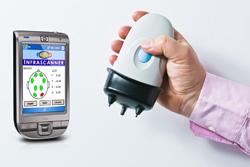
December 14, 2011 – The U.S. Food and Drug Administration (FDA) allowed marketing of the first hand-held device intended to aid in the detection of life-threatening bleeding in the skull called intracranial hematomas, using near-infrared spectroscopy. The device, the Infrascanner Model 1000, can help healthcare providers identify patients with critical head injuries who need an immediate computed tomography (CT) brain imaging study.
Intracranial hematomas occur when blood from a ruptured blood vessel collects within the brain or between the skull and the brain. As blood expands within the brain or in the narrow space between the brain and the skull, the brain becomes compressed. This can produce symptoms such as headaches, vomiting, dizziness, lethargy, weakness in the arm or leg on one side of the body, seizures or unconsciousness. An intracranial hematoma can be life-threatening if it is not treated immediately.
According to the Centers for Disease Control and Prevention, each year about 1.7 million people in the United States experience a traumatic brain injury.
The Infrascanner Model 1000 uses a scanner that directs near-infrared light, a wavelength of light that can penetrate tissue and bone, into the skull. Blood from intracranial hematomas absorbs the light differently than other areas of the brain. The scanner detects differences in light absorption (optical density) and transmits the information wirelessly to a display on a hand-held computer.
By comparing the optical density from a series of scans of specific areas on both sides of the skull, a trained health care provider can use the information provided by the device, in conjunction with other clinical information, to determine the likelihood of an intracranial hematoma and the need for further diagnostic procedures, such as a CT scan.
“While patients with suspected brain injuries routinely receive a CT scan, this portable device offers emergency room physicians a non-invasive mechanism to aid in assessing whether an immediate CT scan is needed,” said Christy Foreman, director of the Office of Device Evaluation at FDA’s Center for Devices and Radiological Health.
The FDA reviewed data for the Infrascanner Model 1000 through the “de novo” classification process, a regulatory pathway for some low- to moderate-risk medical devices that are not comparable to a legally marketed device.
The FDA granted the de novo petition for the Infrascanner Model 1000 based on a review of data comparing results from 383 CT scans of adult subjects with Infrascanner scan results. The Infrascanner was able to detect nearly 75 percent of the hematomas detected by CT scan. When CT scans detected no hematoma, the Infrascanner detected no hematoma 82 percent of the time. The Infrascanner Model 1000, however, is not a substitute for a CT scan.
The FDA is specifying special controls in an accompanying regulation classifying the Infrascanner Model 1000 as a Class II device with special controls. The special controls provide information about specific risks that must be addressed by other manufacturers who may wish to market a similar device.
The Infrascanner Model 1000 is manufactured by InfraScan Inc. of Philadelphia.
For more information: www.infrascanner.com


 December 10, 2025
December 10, 2025 









